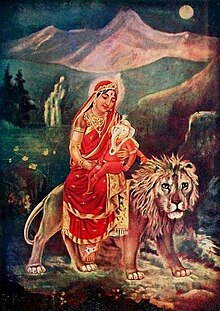
Back Parvati Afrikaans Parvati ALS بارفاتي Arabic بارفاتى ARZ পাৰ্বতী Assamese पार्वती AWA Parvati Azerbaijani Парвати Bashkir Parwati BAN Parvati BCL
| Parvati | |
|---|---|
| Member of Tridevi and Pancha Prakriti | |
 Parvati with her son Ganesha | |
| Other names | Uma, Gauri, Aparna, Durga, Kali, Girija, Haimavati, Ambika, Bhavani |
| Sanskrit transliteration | Pārvatī |
| Devanagari | पार्वती |
| Affiliation | Devi, Shakti, Mahadevi, Tridevi, Sati, Durga, Kali, Navadurga, Mahavidyas |
| Abode | Kailasha, Manidvipa |
| Mantra | Sarvamaṅgalamāṅgalye Śive Sarvārthasādhike । Śaraṇye Tryambake Gauri Nārāyaṇi Namo'stu Te ।। |
| Day | Monday & Friday |
| Mount | Lion and Tiger |
| Texts | Devi-Bhagavata Purana, Mahabhagavata Purana, Devi Mahatmya, Kalika Purana, Shakta Upanishads, Tantras |
| Festivals | Navaratri, Vijayadashami, Teej, Bathukamma, Gauri Habba |
| Genealogy | |
| Parents | Himavan (father) Maināvati (mother)[7][8] |
| Siblings | Ganga (elder sister)[5] Mainaka (elder brother)[6] |
| Consort | Shiva |
| Children | |
| Part of a series on |
| Shaktism |
|---|
 |
|
|
Parvati (Sanskrit: पार्वती, IAST: Pārvatī), also known as Uma (Sanskrit: उमा, IAST: Umā) and Gauri (Sanskrit: गौरी, IAST: Gaurī), is one of the principal goddesses in Hinduism, revered as the goddess of power, energy, nourishment, harmony, love, beauty, devotion, and motherhood. Along with Lakshmi and Sarasvati, she forms the trinity, known as the Tridevi.[9]
From her first appearance as a goddess during the epic period (400 BCE – 400 CE), Parvati is primarily depicted as the chief consort of the ascetic god Shiva.[10] She is recognised as the reincarnation of Sati, Shiva's first wife, who immolated herself after her father insulted Shiva. Parvati is often equated with the other goddesses such as Sati, Uma, Kali and Durga and due to this close connection, they are often treated as one and the same, with their stories frequently overlapping. In Hindu mythology, the birth of Parvati is primarily understood as a cosmic event meant to lure Shiva out of his ascetic withdrawal and into the realm of marriage and household life. As Shiva's wife, Parvati represents the life-affirming, creative force that complements Shiva's austere, world-denying nature. Her presence in his life draws him from isolation into worldly engagement, thus balancing the two poles of asceticism and householder life in Hindu philosophy. Parvati's role as wife and mother is central to her mythological persona, where she embodies the ideal of the devoted spouse who both supports and expands her husband's realm of influence.[10][11] Parvati is also noted for her motherhood, being the mother of the prominent Hindu deities Ganesha and Kartikeya.[6][12][13]
Philosophically, Parvati is regarded as Shiva’s shakti (divine energy or power), the personification of the creative force that sustains the cosmos. In this role, she becomes not only a mother and nurturer but also the embodiment of cosmic energy and fertility. She is the source of power that energises Shiva, who without her is incomplete. Parvati's mythology, therefore, is not just about her role as a wife but also about her cosmic function as the force that activates and sustains life.[10] In various Shaiva traditions, Parvati is also regarded as a model devotee, and even viewed as the embodiment of Shiva's grace, playing a central role in the spiritual liberation of devotees.[10][14][15] She is also one of the central deities in the goddess-oriented sect of Shaktism, where she is regarded as a benevolent aspect of Mahadevi, the supreme deity,[16][17] and is closely associated with various manifestations of Mahadevi, including the ten Mahavidyas and the Navadurgas.[10] Parvati is found extensively in ancient Puranic literature, and her statues and iconography are present in Hindu temples all over South Asia and Southeast Asia.[18][19] In Hindu temples dedicated to her and Shiva, she is symbolically represented as the yoni.[10]
- ^ James D. Holt (2014). Religious Education in the Secondary School: An Introduction to Teaching, Learning and the World Religions. Routledge. p. 180. ISBN 978-1-317-69874-6.
- ^ David Kinsley (19 July 1988). Hindu Goddesses: Visions of the Divine Feminine in the Hindu Religious Tradition. University of California Press. pp. 49–50. ISBN 978-0-520-90883-3.
- ^ Cush, Robinson & York 2008, p. 78.
- ^ Williams 1981, p. 62.
- ^ Siva: The Erotic Ascetic. Oxford University Press. 28 May 1981. ISBN 978-0-19-972793-3. Archived from the original on 4 April 2023. Retrieved 19 March 2023.
- ^ a b Wilkins 2001, p. 295.
- ^ C. Mackenzie Brown (1990). The Triumph of the Goddess: The Canonical Models and Theological Visions of the Devi-Bhagavata Purana. SUNY Press. ISBN 9780791403648. Archived from the original on 26 January 2024. Retrieved 20 August 2019.
- ^ Cite error: The named reference
Mainawas invoked but never defined (see the help page). - ^ Frithjof Schuon (2003), Roots of the Human Condition, ISBN 978-0941532372, pp 32
- ^ a b c d e f Kinsley, David (1998). Hindu Goddesses: Visions of the Divine Feminine in the Hindu Religious Tradition. Motilal Banarsidass Publ. ISBN 978-81-208-0394-7.
- ^ Edward Balfour, Parvati, p. 153, at Google Books, The Encyclopaedia of India and of Eastern and Southern Asia, pp 153
- ^ H.V. Dehejia, Parvati: Goddess of Love, Mapin, ISBN 978-8185822594, pp 11
- ^ Edward Washburn Hopkins, Epic Mythology, p. 224, at Google Books, pp. 224–226
- ^ Ananda Coomaraswamy, Saiva Sculptures, Museum of Fine Arts Bulletin, Vol. 20, No. 118 (Apr. 1922), pp 17
- ^ Stella Kramrisch (1975), The Indian Great Goddess, History of Religions, Vol. 14, No. 4, pp. 261
- ^ H.V. Dehejia, Parvati: Goddess of Love, Mapin, ISBN 978-8185822594
- ^ James Hendershot, Penance, Trafford, ISBN 978-1490716749, pp 78
- ^ Hariani Santiko, The Goddess Durgā (warrior form of Parvati)in the East-Javanese Period, Asian Folklore Studies, Vol. 56, No. 2 (1997), pp. 209–226
- ^ Ananda Coomaraswamy, Saiva Sculptures, Museum of Fine Arts Bulletin, Vol. 20, No. 118 (Apr. 1922), pp 15–24